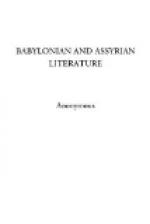[5]Against the tyrant King I go to war,
Attend mine arms, O Queen! with radiant car
Of battles! ride upon the giant King
With thy bright, fiery chargers! valor bring
To me at rising of the glistening car
Of Samas, send attendants fierce of war!
But goddess Mam-nutu of Fate and Death;
Oh, keep away from me her blasting breath;
Let Samas fix the hour with favor thine,
And o’er mine unknown path, Oh ride divine!
Thy servant strengthen with thy godly power
That he invincible in war may tower,
Against thy chosen city’s greatest foe,
Who brought on Erech all her deepest woe.”
And from the inner shrine with curtains hung,
The Oracle of Ishtar sweetly sung:
“O King of vast unnumbered
countries, hear!
Thine enemy Khum-baba do not
fear,
My hands will waft the winds
for thee.
Thus
I reveal!
Khum-baba falls! thine enemy!
Nor
aught conceal.
“The harvest month[6]
propitious shines,
Array great Accad’s
battle lines!
Before thy feet thy Queen
descends,
Before thy will thine Ishtar
bends,
To
fight thine enemy,
To
war I go with thee!
My word is spoken, thou hast
heard,
For thee, my favor thou hast
stirred.
As I am Ishtar of mine Or
divine,
Thine enemy shall fall!
Be glory thine!
“Before mine Izdubar
I go,
And at thy side direct thy
blow.
I go with thee, fear not,
my King,
For every doubt and fear,
I bring
Relief,
to thy heart rest!
Of
Sars, I love thee best!”
[Footnote 1: The account given by Herodotus of the worship of Beltis or Ishtar, if true (see Herodotus, i. 199), was one of the darkest features of Babylonian religion. It is probable that the first intention was only to represent love as heaven-born, and that it afterward became sensual in the time of Herodotus. (See Sayce’s edition Smith’s “C.A. of Gen.,” p. 50.) The presence of the women may have been intended at first to present an innocent attraction. See also Rawlinson’s “Ancient Monarchies,” vol. iii. p. 21.]
[Footnote 2: See Herodotus, vol. i. p. 199. Ishtar was called Mylitta or Beltis in the time of Herodotus. We have taken the above description from Herodotus, whose work is mostly confirmed by the cuneiform inscriptions.]
[Footnote 3: The above psalm is found in vol. iii. of Rawlinson’s “British Museum Inscriptions,” pl. 66, and was translated by H.F. Talbot, F.R.S., in vol. i. of the “Transactions of the Society of Biblical Archaeology,” p. 108, and also by M. Lenormant in his “Premieres Civilisations,” p. 177. We have used Mr. Talbot’s transcription.]
[Footnote 4: See terra-cotta tablet numbered “S. 954” in the British Museum; also translation by Rev. A.H. Sayce, M.A., in the “Records of the Past,” vol. v. p. 157.]
[Footnote 5: See fragment in Sayce’s edition Smith’s “Chald. Acc. of Gen.,” p. 220, col. iii.]




